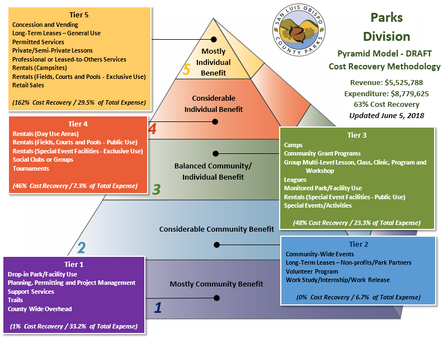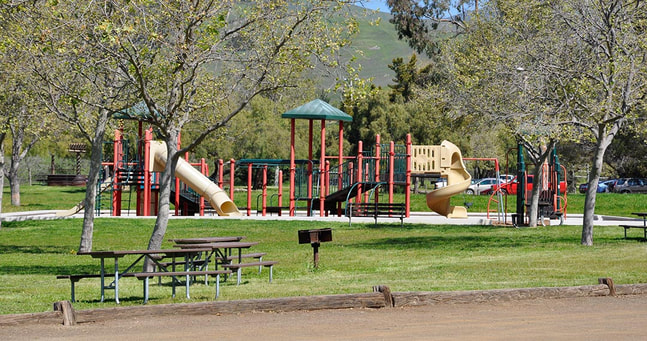Last year, the County adopted a new cost-recovery policy for its Parks and Recreation Department to create a more financially stable funding structure for County parks and continued park and recreation services at existing levels into the future.
The approved cost-recovery policy brings greater clarity and specifies how the Parks Department will come into greater alignment with the County’s current policies.
The approved cost-recovery policy brings greater clarity and specifies how the Parks Department will come into greater alignment with the County’s current policies.
- Regional parks will be operated under a special revenue fund that is largely supported by park user fees. Parks has successfully implemented marketing and pricing strategies to improve fee revenues to maintain services while keeping access to recreation affordable. Parks will not reduce levels of service in areas where cost recovery was at 100% or more, such as campgrounds. This is because those services generate revenue that pay for themselves or help offset costs of other complimentary services.
- Community parks will be operated under the county general fund support. These services are community benefits where the public feels that the services are a public good and should have low to no cost recovery where no user fees are charged, such as playgrounds, picnic grounds, trails and neighborhood parks.

Golf will continue to be operated under an enterprise fund that is largely supported by golf course user fees. Parks has successfully implemented marketing and pricing strategies to improve fee revenues to maintain services while keeping access to golf affordable.
In 2018, the County Parks and Recreation Department worked with GreenPlay, a consulting firm specializing in parks and recreation, to study how the County might recover the cost of providing various parks and recreation services. This process evaluated the mission-based services that County Parks provides, identified the costs to provide those services and made recommendations on cost recovery and subsidy levels for each type of service based on the amount of community benefit versus individual benefit associated with each service.
The study found that the County had not significantly increased General Fund support to its parks and recreation programs over the past 10 years. This resulted in increased fees and deferred maintenance in order to continue services at the same levels. This is not sustainable as costs of doing business increase, the consumer market changes, and the County had limited control to adjust fees to keep pace with those costs.
As a result of the study’s findings, the County Board of Supervisors adopted a comprehensive cost-recovery policy as the framework for the department’s operations, including budgeting, fees, and capital projects funding with targets for services based upon the benefit received by the park user.
In 2018, the County Parks and Recreation Department worked with GreenPlay, a consulting firm specializing in parks and recreation, to study how the County might recover the cost of providing various parks and recreation services. This process evaluated the mission-based services that County Parks provides, identified the costs to provide those services and made recommendations on cost recovery and subsidy levels for each type of service based on the amount of community benefit versus individual benefit associated with each service.
The study found that the County had not significantly increased General Fund support to its parks and recreation programs over the past 10 years. This resulted in increased fees and deferred maintenance in order to continue services at the same levels. This is not sustainable as costs of doing business increase, the consumer market changes, and the County had limited control to adjust fees to keep pace with those costs.
As a result of the study’s findings, the County Board of Supervisors adopted a comprehensive cost-recovery policy as the framework for the department’s operations, including budgeting, fees, and capital projects funding with targets for services based upon the benefit received by the park user.

To develop its new cost-recovery policy, the County used a pyramid methodology built on a foundation of understanding who is benefiting from park and recreation services to determine how the costs for service should be paid and illustrates a pricing philosophy based on establishing fees commensurate with the benefit received.
The pyramids are based on public input through workshops, focus groups and stakeholder input and define the cost recovery targets for each tier of service, from tier 1 (mostly community benefit) to tier 5 (mostly individual benefit). Different cost-recovery pyramid models were used for the Golf Division and the Parks Division because one is an enterprise fund while the other is a special revenue fund, respectively, but the overall policy is the same.
Now, the County will charge user fees to fully recover the costs of providing highly individualized services, such as a campsite, private lessons or exclusive rental of a facility. The County will not charge user fees to recover costs of providing park services that offer broader community benefits, where the public feels that the services are a public good, such as playgrounds, picnic grounds, trails and neighborhood parks.
The pyramids are based on public input through workshops, focus groups and stakeholder input and define the cost recovery targets for each tier of service, from tier 1 (mostly community benefit) to tier 5 (mostly individual benefit). Different cost-recovery pyramid models were used for the Golf Division and the Parks Division because one is an enterprise fund while the other is a special revenue fund, respectively, but the overall policy is the same.
Now, the County will charge user fees to fully recover the costs of providing highly individualized services, such as a campsite, private lessons or exclusive rental of a facility. The County will not charge user fees to recover costs of providing park services that offer broader community benefits, where the public feels that the services are a public good, such as playgrounds, picnic grounds, trails and neighborhood parks.



